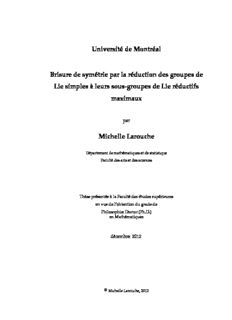
Université de Montréal Brisure de symétrie par la réduction des groupes de Lie simples à leurs ... PDF
Preview Université de Montréal Brisure de symétrie par la réduction des groupes de Lie simples à leurs ...
Université de Montréal Brisure de symétrie par la réduction des groupes de Lie simples à leurs sous-groupes de Lie réductifs maximaux par Michelle Larouche Départementdemathématiquesetdestatistique Facultédesartsetdessciences ThèseprésentéeàlaFacultédesétudessupérieures envuedel’obtentiondugradede PhilosophiæDoctor(Ph.D.) enMathématiques décembre 2012 (cid:13)c MichelleLarouche,2012 Université de Montréal Facultédesétudessupérieures Cettethèseintitulée Brisure de symétrie par la réduction des groupes de Lie simples à leurs sous-groupes de Lie réductifs maximaux présentéepar Michelle Larouche aétéévaluéeparunjurycomposédespersonnessuivantes: PavelWinternitz (président-rapporteur) JiriPatera (directeurderecherche) AlfredMichelGrundland (membredujury) MarkWalton (examinateurexterne) NeilStewart (représentantdudoyendelaFES) Thèseacceptéele: 19novembre2012 v RÉSUMÉ Dans ce travail, nous exploitons des propriétés déjà connues pour les sys- tèmes de poids des représentations afin de les définir pour les orbites des groupesdeWeyldesalgèbresdeLiesimples,traitéesindividuellement,etnous étendons certaines de ces propriétés aux orbites des groupes de Coxeter non cristallographiques. D’abord, nous considérons les points d’une orbite d’un groupedeCoxeterfiniGcommelessommetsd’unpolytope(G-polytope)cen- tré à l’origine d’un espace euclidien réel à n dimensions. Nous introduisons lesproduitsetlespuissancessymétriséesdeG-polytopesetnousendécrivons la décomposition en des sommes de G-polytopes. Plusieurs invariants des G- polytopessontprésentés.Ensuite,lesorbitesdesgroupesdeWeyldesalgèbres de Lie simples de tous types sont réduites en l’union d’orbites des groupes de Weyldessous-algèbresréductivesmaximalesdel’algèbre.Nouslistonslesma- trices qui transforment les points des orbites de l’algèbre en des points des or- bites des sous-algèbres pour tous les cas n ≤ 8 ainsi que pour plusieurs séries infiniesdespairesd’algèbre-sous-algèbre.Denombreuxexemplesderèglesde branchement sont présentés. Finalement, nous fournissons une nouvelle des- cription, uniforme et complète, des centralisateurs des sous-groupes réguliers maximaux des groupes de Lie simples de tous types et de tous rangs. Nous présentons des formules explicites pour l’action de tels centralisateurs sur les représentations irréductibles des algèbres de Lie simples et montrons qu’elles peuventêtreutiliséesdanslecalculdesrèglesdebranchementimpliquantces sous-algèbres. Mots clés: groupes de Weyl, algèbres de Lie simples, sous-algèbres réduc- tivesmaximales,réduction,matricesdeprojection,centralisateurs. vii ABSTRACT Inthiswork,weexploitpropertieswellknownforweightsystemsofrepre- sentationstodefinethemforindividualorbitsoftheWeylgroupsofsimpleLie algebras,andweextendsomeofthesepropertiestoorbitsofnon-crystallographic Coxeter groups. Points of an orbit of a finite Coxeter group G are conside- red as vertices of a polytope (G-polytope) centered at the origin of a real n- dimensionalEuclideanspace.ProductsandsymmetrizedpowersofG-polytopes are introduced and their decomposition into the sums of G-polytopes is des- cribed.SeveralinvariantsofG-polytopesarefound.TheorbitsofWeylgroups of simple Lie algebras of all types are reduced to the union of orbits of the Weyl groups of maximal reductive subalgebras of the algebra. Matrices trans- forming points of the orbits of the algebra into points of subalgebra orbits are listed for all cases n ≤ 8 and for many infinite series of algebra-subalgebra pairs. Numerous examples of branching rules are shown. Finally, we present a new, uniform and comprehensive description of centralizers of the maximal regular subgroups in compact simple Lie groups of all types and ranks. Expli- cit formulas for the action of such centralizers on irreducible representations of the simple Lie algebras are given and shown to have application to compu- tationofthebranchingruleswithrespecttothesesubalgebras. Keywords: Weyl groups, simple Lie algebras, maximal reductive subalge- bras,reduction,projectionmatrices,centralizers. ix TABLE DES MATIÈRES Résumé.................................................................. v Abstract ................................................................. vii Listedestableaux........................................................ xv Listedesfigures .........................................................xvii Remerciements.......................................................... xix Introduction............................................................. 1 Chapitre1. Theringsofn-dimensionalpolytopes..................... 9 1.1. Introduction .................................................... 10 1.2. ReflectionsgeneratingfiniteCoxetergroups..................... 14 1.2.1. n = 1......................................................... 14 1.2.2. n = 2......................................................... 15 1.2.3. Generalcase:CoxeterandDynkindiagrams ................. 15 1.3. Rootandweightlattices......................................... 17 1.4. TheorbitsofCoxetergroups .................................... 18 1.4.1. Computingpointsofanorbit................................. 18 1.4.2. OrbitsofA ,C ,G ,andH .................................. 19 2 2 2 2 1.4.3. OrbitsofA ,B ,C ,andH ................................... 21 3 3 3 3 1.5. Orbitsaspolytopes.............................................. 22 1.5.1. Explanationofthetables ..................................... 23 x 1.6. Decompositionofproductsofpolytopes......................... 27 1.6.1. MultiplicationofG-invariantpolynomials.................... 27 1.6.2. ProductsofG-orbits.......................................... 28 1.6.3. Two-dimensionalexamples................................... 29 1.6.4. Three-dimensionalexamples................................. 30 1.6.5. DecompositionofproductsofE orbits....................... 30 8 1.7. Decompositionofsymmetrizedpowersoforbits ................ 31 1.7.1. SymmetrizedpowersofG-polynomials....................... 31 1.7.2. SymmetrizedpowersofG-orbits ............................. 32 1.7.3. Two-dimensionalexamples................................... 33 1.7.4. Three-dimensionalexamples................................. 34 1.8. Congruenceclasses,indices,andanomalynumbersofpolytopes 35 1.8.1. Congruenceclasses........................................... 35 1.8.2. Thesecondandhigherindices................................ 36 1.8.3. Anomalynumbers ........................................... 37 1.9. Concludingremarks ............................................ 40 Chapitre2. BranchingrulesfortheWeylgrouporbitsoftheLiealgebra A .......................................................... 43 n 2.1. Introduction .................................................... 44 2.2. Preliminaries.................................................... 48 2.3. Constructionofprojectionmatrices.............................. 49 2.4. Equidimensionalorbitbranchingrules.......................... 50 2.4.1. OrbitbranchingrulesforA ⊃ A ×U .................... 51 n n−1 1 2.4.1.1. A ⊃ U .................................................. 51 1 1 2.4.1.2. A ⊃ A ×U ............................................ 51 2 1 1 2.4.1.3. A ⊃ A ×U ............................................ 51 3 2 1
Description: